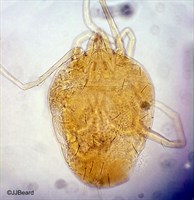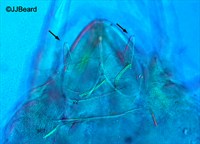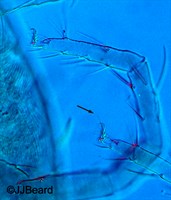Click on images to enlarge

Fig. 1. Petrobia latens adult female (non-type) - dorsum.

Fig. 2. Petrobia latens adult female (non-type) - dorsal habitus.

Fig. 3. Petrobia latens adult female (non-type) - detail of emergent peritremes (indicated by arrows).

Fig. 4. Petrobia latens adult female (non-type) - lateral aspect of empodium showing longer lateral tenent hairs (indicated by arrow).
Material examined
non-types
Taxonomy
Subfamily Bryobiinae
Tribe Petrobiini
Common Name
Brown wheat mite
Distribution
+Australia, Algeria, Argentina, CIS, Chile, China, *Denmark, Egypt, France, Germany, Hungary, India, Iran, Ireland, Italy, Japan, Korea, Mexico, New Zealand, Pakistan, Poland, South Africa, Spain, The Netherlands, Turkey, UK, USA, Zimbabwe
Taxonomy Changes
Acarus latens Muller 1776
Petrobia latens (Muller) Oudemans 1915
Petrobia (Petrobia) latens (Muller) Waintsein 1960
Acarus praegnans Schrank 1781, synonymy Pritchard & Baker 1955
Acarus petrarum Fourcroy 1785, synonymy Pritchard & Baker 1955
Trombidium lapdium Hammer 1804
Petrobia lapidum (Hammer) Oudemans 1915, synonymy Pritchard & Baker 1955
Tetranychus anauniensis Canestrini 1889, synonymy Pritchard & Baker 1955
Tetranychopsis simplex Tragardh 1904, synonymy Pritchard & Baker 1955
Tetranychopsis paupera Berlese 1910, synonymy Pritchard & Baker 1955
Tetranychus longipes Banks 1912, synonymy Pritchard & Baker 1955
Tetranobia decepta Banks 1917, synonymy Pritchard & Baker 1955
Tetranychina tritici Ewing 1921, synonymy Pritchard & Baker 1955
Petrobia cepae Sayed 1946, synonymy Pritchard & Baker 1955
Petrobia erevanica Reck & Bagdasarian 1949, synonymy Pritchard & Baker 1955
Diagnosis
Female (Fig. 1)
- dark reddish
- dorsal setae not set on tubercles (Fig. 2)
- all dorsal setae shorter than distance to seta in next row (Fig. 2)
- legs about as long as body
- peritreme ending in protruding elongate anastomosing chamber (Fig. 3)
- empodium (claw-like) shorter than lateral tenent hairs (Fig. 4)
Males are unknown
Hosts
*type host unknown
> 90 reocorded species of host plant, including: Acacia giraffae (Mimosaceae), Allium cepa, A. sativum (Alliaceae), Artemisia herba-alba, A. tridentata (Asteraceae), Avena sativa (Poaceae), Bromus arizonicus. B. willdenowii (Poaceae), Cajanus cajan (Fabaceae), Cenchrus echinatus (Poaceae), Chenopodium album (Chenopodiaceae), Cichorium endivia, C. intybus (Asteraceae), Echinochloa crusgalli, Elymus canadensis, E. elymoides (Poaceae), Ficus carica (Moraceae), Fragaria sp. (Rosaceae), Gladiolus hortulanus (Iridaceae), Glycine max (Fabaceae), Gossypium hirsutum (Malvaceae), Haplopappus spinulosus (Asteraceae), Hordeum vulgare, Imperata cylindrica (Poaceae), Iris missouriensis (Iridaceae), Lactuca sativa (Asteraceae), Medicago sativa (Fabaceae), Mentha incana (Lamiaceae), Morus alba (Moraceae), Oenothera clavaeformis, O. primiveris (Onagraceae), Oxalis sp. (Oxalidaceae), Phaseolus angularis, P. vulgaris(Fabaceae), Potentilla argentea, P. norvegica (Rosaceae), Saccharum officinarum (Poaceae), Trifolium sp. (Fabaceae), Triticum aestivum (Poaceae), Vicia hirsuta, V. sativa (Fabaceae), Vitis vinifera (Vitaceae), Zea mays (Poaceae)
Biology
Males of Petrobia latens are unknown as the species reproduces parthenogenetically.
This species is a dry weather pest in Australia, causing damage to grain and several vegetable crops. Eggs are laid parthenogenetically by females on the soil and under stones.
Petrobia latens has a world wide distribution and an extensive host range, of which monocots are the most important. During a dry spring, preceeded by winter rain, P. latens may develop large populations and do considerable damage to wheat in certain areas. During early spring the diapause eggs can be found under clods in wheat growing areas. These eggs are white with a circular radially striate cap. Non-diapause eggs are red, radially striate and have a short stipe. As grasses are a major host, this species can move into wheat crops from grasses and cause either a primary infestation of the area or a reinfestation. This species, like several species of Bryobia, often invade houses in areas where huge populations have built up.
References
Banks, N. (1912) New American mites. Proc. Entomol. Soc. Wash. 14: 96-99
Banks, N. (1917) New mites, mostly economic (Arach. Acar.). Entomol. News 28: 193-199
Berlese, A. (1910) Lista di nuove specie e nuove generi di acari. Redia 6: 242-271
Canestrini, G. (1889) Prospetto dell'acarofauna Italiana, Famiglia dei Tetranychini. Atti. Reale. Ist. Ven. Sci., Lett. Arti. (ser. 6) 7: 491-540
Ewing, H.E. (1921) New nearctic spider mites of the family Tetranychidae. Proc. U.S. Nat. Mus. 59: 659-666
Fourcroy, A.F. (1785) Entomologia Parisiensis. Paris, 1: 1-231; 2: 233-544
Hermann, J.F. (1804) Mem. Apterologique, Strasbourg: 144pp.
*Muller, O.F. (1776) Zoologie Danicae Prodromus. Copenhagen: 282pp.
Oudemans. A.C. (1915) Notizen uber Acari. Archiv. Naturg. 81: 1-78
Pritchard, A.E. and Baker, E.W. (1955) A revision of the spider mite family Tetranychidae. Pacific Coast Entomology Society Memoirs 2: 1-472
Reck, G.F. and Bagdasarian, A.T. (1949) Opisanie novyh vidov ie rodov Petrobia i Tetranychina (Tetranychidae, Acariina). Dokl. Akad. Nauk Arm. S.S.R. 10: 189-192
Reck, G.F. (1959) A key to tetranychoid mites. Fauna Trans. Caucasia Akad. Nauk Gruz. S.S.R. 1: 1-152
Sayed, M.T. (1946) Contribution to the knowledge of Acarina of Egypt. V. Five new species of Tetranychidae. Bull. Soc. Fouad., Ier Entomol. 30: 79-97
Schrank, F.P. (1781) Enumeratio Insectorum Austriae Indigenorum. Beitr. natur. Augsburg, Germany, 8: 548 pp.
Tragardh, I. (1904) IV. Acariden aus Agypten und dem Sudan. 1. Teil. Results Swedish Zool. Exped. Egypt White Nile, 1901, Upsala, 20: 1-124
Wainstein, B.A. (1960) Tetranychoid mites of Kazakhstan (with revision of the family). Kazakh. Akad. Sel'sk. Nauk. Nauch. Issled. Inst. Zashch. Rast. Tr. 5: 1-276
+Womersley, H. (1940) Studies in Australian Acarina, Tetranychidae and Trichadenidae. Transactions of the Royal Society of South Australia 64: 233-265
Copyright © 2018. All rights reserved.